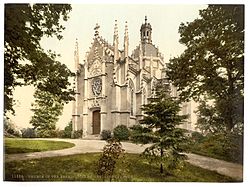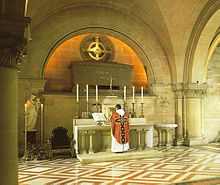St Michael's Abbey, Farnborough
 Saint Michael's Abbey Church | |
| Monastery information | |
|---|---|
| Other names | Farnborough Abbey |
| Order | Order of Saint Benedict |
| Established | 1881 |
| Dedicated to | Saint Michael the Archangel |
| Diocese | Portsmouth |
| Controlled churches | St. Michael's Abbey Church |
| People | |
| Founder(s) | Eugénie de Montijo |
| Abbot | Dom Cuthbert Brogan |
| Important associated figures | |
| Site | |
| Location | Farnborough, Hampshire, United Kingdom |
| Coordinates | 51°17′48″N 0°45′00″W / 51.2968°N 0.7499°W |
| Grid reference | SU873560 |
| Public access | Yes |
Saint Michael's Abbey (French: Abbaye Saint-Michel) is a Benedictine abbey in Farnborough, Hampshire, England. The small community is known for the quality of its liturgy, which is sung in Latin and Gregorian Chant, its pipe organ, and its liturgical publishing and printing.
Pope Pius IX granted a Canonical coronation towards the venerated image of Saint Joseph in 13 April 1874. Public tours of the Abbey take place every Saturday at 3pm, with the tour comprising a tour of the church and a visit to the crypt. Organ recitals are held on the first Sunday afternoon of the month between May and October at 3pm.
History



Following the fall of the Second French Empire in 1870, Napoleon III (1808–1873), his wife Empress Eugénie (1826–1920) and their son the Prince Imperial (1856–1879) were exiled from France and took up residence in Chislehurst, England, where Napoleon III died in 1873. He was originally buried at St Mary's Catholic Church, Chislehurst, but, following the death of the Prince Imperial in 1879, the grief-stricken Eugénie set about building a monument to her family. She founded the abbey in 1881 as a mausoleum for her husband and son, wishing that the burial place should be a place of prayer and silence.[1] The Abbey included an Imperial Crypt, modelled on the altar of St Louis in France, where the Emperor had originally desired to be buried,[1] where Eugénie was later buried alongside her husband and son. All three rest in granite sarcophagi provided by Queen Victoria. The Abbey Church itself was designed in an eclectic flamboyant gothic style by the renowned French architect Gabriel-Hippolyte Destailleur and contains the thigh bone of St Alban, the largest relic of the saint in England.
After the church and monastery were founded, they were initially administered by Premonstratensian Canons. In 1895, the Empress replaced them with French Benedictine monks from St Peter's Abbey, Solesmes. Fernand Cabrol, monk and scholar, became prior and afterwards abbot (1903); Henri Leclercq and a small group of French monks joined the house at the same time, and Leclercq and Cabrol collaborated for many years in scholarly endeavours. The church's present two-manual organ was installed in 1905, built by Aristide Cavaillé-Coll & Company. The instrument's origins are shrouded in mystery. Although installed after the death of Cavaillé-Coll, it bears his name rather than that of his son-in-law Mutin, and the internal works are of a quality which identifies this model with the highest standards of workmanship of the high days of that company.
The medieval scholar Dom André Wilmart (1876–1941) was a liturgist at the abbey. The community, once famed for its scholarly writing and musical tradition of Gregorian chants, became depleted in number by 1947, and was augmented by a small group of English monks from Prinknash Abbey in Gloucestershire. The last French monk, Dom Zerr, died in 1956. In 2006 the community elected the first English Abbot of Farnborough—the Right Reverend Dom Cuthbert Brogan.
Catholic National Library
The Catholic Central Library was set up by the Catholic Truth Society after the First World War. It was maintained for many years by the Graymoor Friars in Westminster until they were obliged to withdraw. It moved into the care of St Michael's Abbey in 2007 for a probationary period pending a final decision on its future. In 2007 it was renamed the Catholic National Library, and is one of the finest collections of Catholic books in England. In 2015 the collection was relocated to Durham University Library.[2]
References
- ^ a b "The Crypt at St Michael's Abbey". St Michael's Abbey. 2007. Archived from the original (Website) on 2007-10-30. Retrieved 2007-10-26.
{{cite web}}: Cite has empty unknown parameter:|coauthors=(help); External link in|authorlink=|deadurl=ignored (|url-status=suggested) (help) - ^ "Catholic National Library moves to Durham University". Catholic Herald. 22 October 2015. Retrieved 24 October 2015.
External links
- Official website
- Website about the famous Cavaillé-Coll organ in Farnborough Abbey
- St Michael's Abbey (Newsreel). British Pathé. 1953. Archived from the original on 2011-06-11. Retrieved 6 March 2010.
{{cite AV media}}: Unknown parameter|dead-url=ignored (|url-status=suggested) (help)

